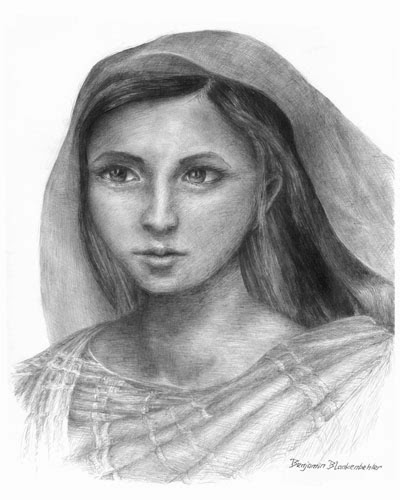 |
Basic Shape Proportions Hair Eyes & Forehead Nose & Cheeks Lips & Chin Neck & Chest Clothing |
Portraits have always been the hardest thing for me to draw. But through study and lots of practice, I have learned a constructive technique. The subject in this step by step tutorial is being drawn straight out of my head. No photograph to copy, though I look at several artworks for reference.
Basic Shape |
Start with a basic oval shape. This is an abstract outline of the skull and muscles around the skull. A second horizontal oval suggests the shape of the skull as it foreshortens back to the rear of the head. This second oval determines the direction the face is looking. For this tutorial, we will see the face slightly from the side and slightly from below. This position gives her dignity but is not confrontational, but calm.
The age, sex, ethnicity and other factors of our subject determine the shape of these ovals. But don’t worry, it does not have to be precise yet. You can practice this step by just drawing ovals around photographs of people’s heads. |
Proportions
   |
Now, we find the indents around the temple and jaw. In order to do this, we need to know proportions of the parts the head. You need to be familiar with the bone structure and muscles. I’m not saying you have memorize every anatomical part, but just keep in mind that this is what gives the head its shape. Draw a horizontal circle in perspective for the eyes. Draw another horizontal circle for the mouth. We will use these basic points to find the location of lips, nose, eyes, eyebrows, ears, and hair line. These all need to be symmetrical, so draw a vertical circle in perspective straight down the middle. Make the eyes equal distance away from this center, as well as the rest of the elements. Do all this in correct perspective.  Doing all this in perspective is difficult and will take some time. The proportions of the face depend on a person’s age, sex, race, and ethnicity. As a general guide, the eyes are halfway between the top and bottom. The nose tip is halfway between the eyes and bottom, and the bottom lip is halfway between the nose and bottom. Yes, I know. The image to the left looks freaky. I start to consider how the skin fits onto the parts of the head. Also, I introduced the neck, body, and clothes. I start to consider the subject’s expression, which is determined by how the muscles manipulate the other elements. This is all still anatomical, but will lead to the mood and composition. Many proportions also obviously need to be refined. Compositionally, I am interested in how the hair and clothing directs eye movement. I am also considering how shade and shadow help the eye movement, and add interest with contrast. As you can see, I start to lightly sketch where highlight and shadow should go, depending on the location of the light source. Note that I am still refining the proportions on the face throughout the entire drawing process. The proportions of the face need to be perfectly correct, because people recognize faces better than anything else in the world. Just a fraction of a millimeter off will make the face look warped. Look at the image through a mirror to make sure it is symmetrical. |
Hair
Eyes & Forehead
Nose & Cheeks
Lips & Chin
Neck & Chest
Clothing
 |
 |
















